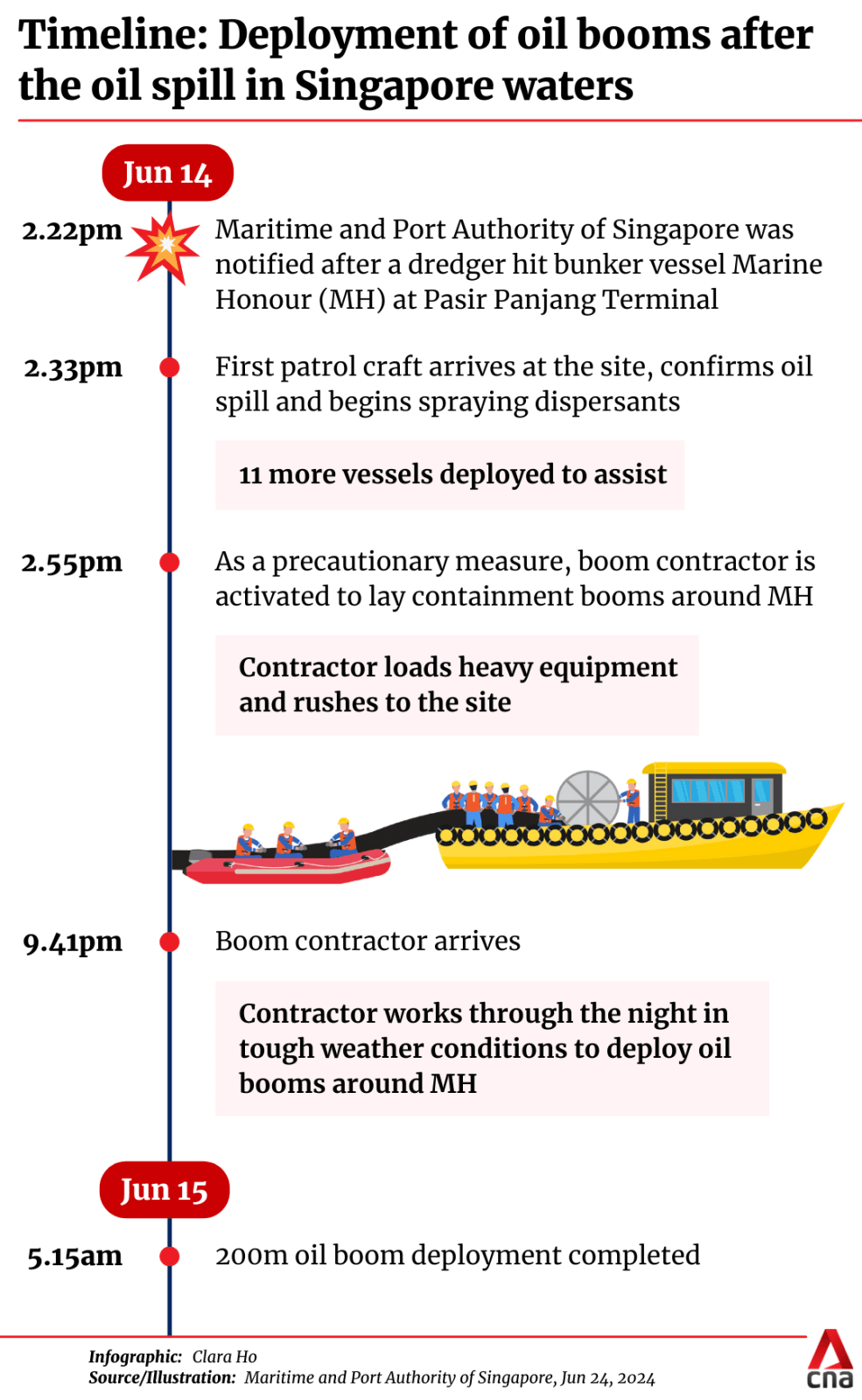Government agencies have done well in oil spill clean-up, SOPs effective: Chee Hong Tat
Transport Minister Chee Hong Tat also addressed questions on why containment booms were not pre-emptively deployed at beaches.

Minister for Transport Chee Hong Tat speaks at a press conference on Jun 24, 2024, addressing the oil spill clean-up operations. (Photo: CNA/Marcus Mark Ramos)

This audio is generated by an AI tool.
SINGAPORE: Standard operating procedures (SOPs) were effective in cleaning up the 400 tonnes of oil that spilled in Singapore waters after a recent maritime accident, Transport Minister Chee Hong Tat said.
Government agencies, its industry partners and volunteers have also done well in managing the incident, said the minister, who oversees the Maritime and Port Authority of Singapore (MPA), at a press conference on Monday (Jun 24).
Minister for National Development Desmond Lee and Minister for Sustainability and the Environment Grace Fu were present at the press conference.
Mr Chee addressed questions on why containment booms were not pre-emptively deployed around beaches such as Sentosa and East Coast Park to prevent oil from reaching these areas.
The oil spill occurred on the afternoon of Jun 14 after a Netherlands-flagged dredger hit a stationary bunker vessel, causing oil from the latter's damaged cargo tank to spill into the water.
Detailing the timeline of events that day, Mr Chee said the response to the incident was well within industry standards.
The first MPA patrol craft arrived 11 minutes after the incident at 2.33pm to spray dispersants at the water, and at 2.55pm, MPA contacted boom contractor T&T Salvage Asia to lay containment booms around the damaged bunker vessel.
The team from T&T Salvage needed a few hours to load the heavy equipment and another few hours to sail to the site, said Mr Chee. Its boat arrived at the site at 9.41pm.
Despite the challenges of working at night and under bad weather conditions, T&T “did well to deploy 200m of oil booms around the damaged vessel by working through the night”, and the deployment of the booms was completed at 5.15am the next day, Mr Chee said.
“The steps taken by MPA and T&T and their response times are in line with international industry practices for responses to oil spills.”
Furthermore, Mr Chee said Singapore has an established SOP for oil spills, and that an oil spill response exercise is conducted every two years which involves government agencies and industry partners.
The last exercise was conducted in 2022 and the next exercise is planned for October this year.

BOOMS COULD NOT HAVE PREVENTED THE SPREAD OF OIL
Mr Chee said that there is “some misperception” that the booms could have prevented the oil from floating away and going onto Singapore's shores.
An oil spill is not the same as spilling coffee onto the floor, the minister said.
“If you spill coffee on the floor, the coffee will remain there, you can go get a mop and clean,” he said. “Oil that spills into the ocean, especially if it’s a sudden discharge, a large amount, like what happened on Jun 14, the oil will not remain stationary.
As deploying the containment boom around the oil spill would take several hours, "we must expect a significant amount of oil that is spilled in the sea to be carried by tidal currents and waves to other locations".
Thus the main purpose of the containment around the damaged vessel is not to “fence in” the oil that has been spilled but a preventive measure in case of further leaks from the damaged vessel.
“The containment boom can also help catch some of the oil spill which remain in the vicinity of the incident location and did not float elsewhere. But this is also not 100 per cent foolproof, because the tidal currents and waves can carry the oil to go below and above the booms,” he said.
As to why the booms were not pre-emptively deployed to prevent oil from reaching beaches, he said it is simply not feasible to deploy booms along the entire coastline of Singapore.
“If you are going to deploy booms along the entire southern coastline from Pasir Panjang to East Coast, that would require more than 46km of booms,” he said.
The booms would also require maintenance and replacement as they are subject to the elements and some can snap.
So, MPA would first assess the movement of the oil before deploying the booms.
“MPA had therefore deployed vessels and crew to monitor surrounding waters signs of oil while it alerted other agencies to step up monitoring of the coastline,” he said.
It also used predictive modelling of where the oil would move based on tidal predictions and real-time weather data, as well as predictions using satellite images.
“This targeted approach is consistent with international practice, and ensures that the booms available are placed where they can be most effective,” he said.
Since Jun 14, about 3.4km of booms have been laid to stop oil from flowing back to the sea, and to prevent oil from being washed ashore and into inland canals.
COULD THE BOOMS HAVE BEEN DEPLOYED QUICKER?
Responding to a question by CNA on whether MPA is looking to improve on how quickly booms are deployed in an oil spill, Mr Chee said that the speed of deployment depends on many factors.
“So if in a situation where it is a daytime operation and the weather is fine, definitely, I think the operator will be able to deploy more quickly compared to the situation that we had that day when it was night time and the weather conditions were not very good.”
CNA also asked why MPA did not mention in its first media statement on the incident on Jun 14 about the possible spread of the oil spill.
Mr Chee said that the immediate response was to deal with the issues at the incident site itself.
“First is to make sure that there's no more spillage from the damaged vessel, because if you have oil that continues to come out in large amounts from the vessel, I think that will make the situation even worse,” he said.
“They had to make sure first of all that the vessel is safe, it will not be at risk of sinking, the crew are okay (and) the damaged tank would not have continued spillage of oil,” he said.
He added that the authorities also did not know where the oil would go.
“You don't quite know at that point in time where you will float to, so therefore, which of the shores and the beaches will be affected.”
On the day of the incident, MPA had alerted agencies, including the National Environment Agency, National Parks Board and Sentosa Development Corporation to be on the lookout for oil traces.

















